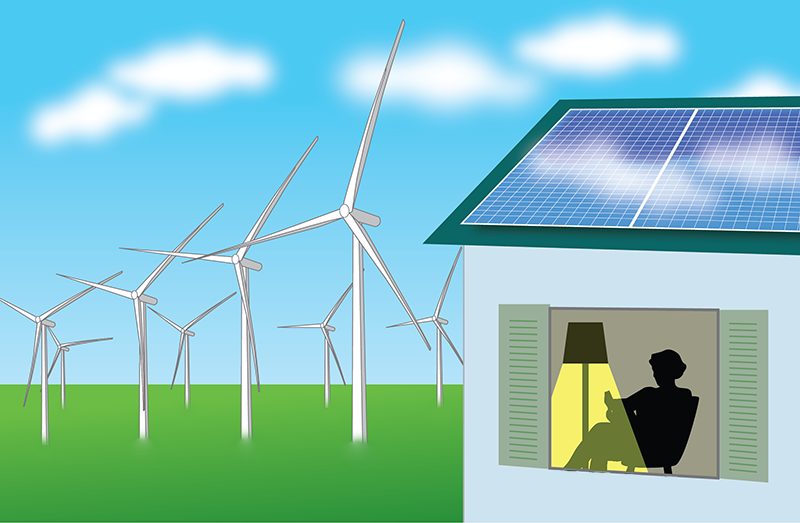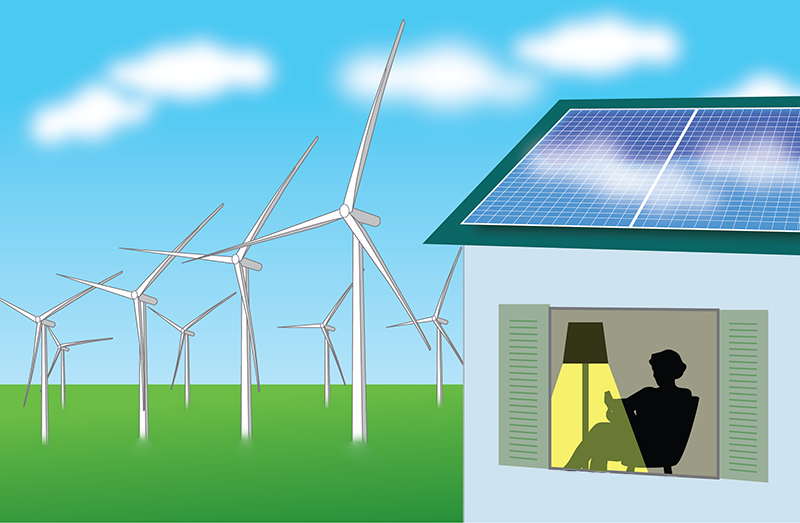Renewable Energy’s Intermittency is Not a Showstopper
This article is part of a series of pieces on environmental topics that Physics is publishing to celebrate Earth Day (April 22). See also: Research News: Breaking Barriers to Polymer Recycling; Arts & Culture: Serenading a Troubled Ocean; News Feature: The Answer is Blowing in the Turbine; Q&A: The Lure of Cement.
The greatest question facing the world as we transition away from traditional fuels to 100% clean, renewable energy is whether we can keep the electricity grid stable every minute of every day given the variability of wind and sunlight. My answer is yes! We can avoid blackouts by taking advantage of multiple tools that are already available.
Clean, renewable energy is energy that is naturally replenishable, results in no emissions of health- or climate-affecting air pollutants, and does not pose other major environmental threats. The main clean, renewable electricity-generating technologies are onshore and offshore wind turbines, solar photovoltaics, concentrated solar power plants, geothermal plants, and hydropower plants. Collectively, these are called wind-water-solar (WWS) technologies.
Electricity-generating technologies that aren’t clean and renewable involve fossil fuels, biomass, and nuclear energy. Fossil fuel and biomass power plants produce air pollution—a problem not solved by adding carbon capture technology to these plants. The main concerns with nuclear power are radioactive waste, the pollution from mining and refining uranium, the meltdown risk of reactors (1.5% of all energy-supplying reactors ever built have experienced some level of accidental core melting), and the possibility of nuclear weapons proliferation.
But these polluting energies are often deemed necessary for maintaining reliable power production. And yet, the ability to avoid blackouts with 100% WWS is already a reality in several countries. In 2021, 10 countries—Iceland, Norway, Costa Rica, Albania, Paraguay, Bhutan, Namibia, Nepal, Ethiopia, and the Democratic Republic of the Congo—produced 97.5 to 100% of all their electricity from WWS resources. Some of these countries even produced excess electricity that they could sell to their neighbors: Paraguay exported electricity to Argentina and Brazil, and both Bhutan and Nepal exported energy to India.
In all the 100% WWS countries listed above, the dominant renewable is hydropower. Of course, not all countries have a large hydropower capacity, so reaching 100% WWS electricity for many countries will require 90% or more of electricity generation from wind and solar. A common worry is that consumers will face blackouts when the wind doesn’t blow, or the Sun doesn’t shine. However, we can make a WWS-supplied grid stable by combining a number of methods. First, wind and solar energies are complementary in that the Sun often shines when the wind isn’t blowing, and vice versa. Thus, combining wind and solar smooths the power supply compared with using wind or solar alone. Similarly, combining wind or solar energy from distant facilities can average over productivity lulls in particular locations.
The location of wind farms can also have an influence on grid stability. Building wind turbines in coastal waters helps in meeting spikes in electricity demand because offshore wind is usually less variable than onshore wind and often peaks when electricity demand peaks. Building more wind turbines in cold climates also increases reliability because, on average, when temperatures drop and heating demand goes up, winds become stronger.
Another grid-stabilizing strategy is electricity storage, which can often fill gaps in wind and solar supply. Existing electricity storage technologies include batteries, pumped hydropower storage, flywheels, compressed air storage, and so-called gravity storage. In many places, solar plus batteries is already cheaper than coal or nuclear and is replacing both. In fact, battery costs have declined 97% since 1991. The more storage costs decline, the more storage will be coupled with WWS generation to keep the grid stable.
Other ways to avoid blackouts focus on demand. Efficiency improvements—such as switching to LEDs and insulating buildings—can reduce electricity consumption. Utilities can also give financial incentives to encourage consumers to shift the time of their energy use to periods when sunlight or wind is available.
I’ve studied the use of these techniques in 143 countries and 50 states and found that the grid can stay stable everywhere in the world with 100% WWS. There are many incentives to make the transition. For one, a fully WWS-based energy supply would reduce energy needs, primarily because it would imply a transition from gas-fueled vehicles to more efficient electric vehicles. Other motivations include less pollution-related diseases and reduced environmental impacts.
To take the example of the US, my estimates show that a full transition to WWS in 2050 would reduce energy needs by 57%, energy costs by 63%, and energy plus health plus climate costs by 86%—compared with a business-as-usual scenario. The health savings are based on an estimated 53,000 less air-pollution deaths per year (multiplied by a “value of life” factor of around $11 million per death); the climate savings come from assuming a societal cost of $550 per metric ton of CO2 emitted. In addition, a 100% WWS scenario in the US would create a net gain of 4.7 million jobs.
In sum, there are many tools available to keep the grid stable with 100% WWS. Doing so will reduce costs, increase employment, reduce pollution-related deaths, mitigate climate damage, and provide energy security. In order to avoid the worst climate damage, we need to stop emissions immediately, but—barring that—we need at least an 80% transition by 2030 and a 100% transition, ideally, by 2035–2040 but no later than by 2050. We have at least 95% of the technologies we need for a transition today. As such, we have no excuse not to proceed as rapidly as possible.
Correction (25 April 2022): A previous version incorrectly stated the societal cost of air pollution as $550 million per metric ton of CO2 emitted.





